Machine-Learning-Based COVID-19 and Dyspnoea Prediction Systems for the Emergency Department
Abstract
Featured Application
Abstract
1. Introduction
- A careful clinical features collection: we based our classifiers on the features that physicians employed during triaging and daily clinical operations;
- Extensive and robust data analysis before ML clustering;
- Exploitation blood tests to assess patients, rather than imaging data;
- Assessment of patients’ need for oxygen therapy to carefully engage limited resources in contingency scenarios [21];
- A quantitative lung involvement examination to produce robust results: studies report lung ultrasound examination as a fast, cheap, and agile tool to assess patients’ lung involvement [2].
2. Materials and Methods
2.1. Data Collection
2.2. Data Exploration
2.3. Machine Learning Models
3. Results and Discussion
4. Conclusions
Author Contributions
Funding
Institutional Review Board Statement
Informed Consent Statement
Data Availability Statement
Acknowledgments
Conflicts of Interest
Abbreviations
| Acronym | Description |
| A-a-g/A-a | Arterial–Alveolar Gradient |
| ABG | Arterial Blood Gas |
| AI | Artificial Intelligence |
| ARDS | Acute Respiratory Distress Syndrome |
| AUC | Area Under the Curve |
| BGA | Blood Gas Analyses |
| Bp | Blood Pressure |
| CPAP | Continuous Positive Airway Pressure |
| CT | Computed Tomography |
| ED | Emergency Department |
| GUI | Graphical User Interface |
| LUS | Lung Ultrasound |
| PCA | Principal Component Analysis |
| Pp | Partial Pressure |
| RBF | Radial Basis Function |
| RF | Random Forest |
| ROC | Receiver Operating Characteristic |
| rRT-PCR | (real-time) Reverse Transcription-Polymerase Chain Reaction (rRT-PCR) |
| SVM | Support Vector Machine |
References
- Livingston, E.; Bucher, K.; Rekito, A. Coronavirus Disease 2019 and Influenza 2019–2020. JAMA 2020, 323, 1122. [Google Scholar] [CrossRef] [PubMed]
- La Salvia, M.; Secco, G.; Torti, E.; Florimbi, G.; Guido, L.; Lago, P.; Salinaro, F.; Perlini, S.; Leporati, F. Deep learning and lung ultrasound for COVID-19 pneumonia detection and severity classification. Comput. Biol. Med. 2021, 136, 104742. [Google Scholar] [CrossRef] [PubMed]
- Mohanty, S.K.; Satapathy, A.; Naidu, M.M.; Mukhopadhyay, S.; Sharma, S.; Barton, L.M.; Stroberg, E.; Duval, E.J.; Pradhan, D.; Tzankov, A.; et al. Severe Acute Respiratory Syndrome Disease 19 (COVID-19)—Anatomic Pathology Perspective on Current Knowledge. Diagn. Pathol. 2020, 15, 103. [Google Scholar] [CrossRef] [PubMed]
- Wiersinga, W.J.; Rhodes, A.; Cheng, A.C.; Peacock, S.J.; Prescott, H.C. Pathophysiology, Transmission, Diagnosis, and Treatment of Coronavirus Disease 2019 (COVID-19): A Review. JAMA 2020, 324, 782–793. [Google Scholar] [CrossRef] [PubMed]
- Lai, C.K.C.; Lam, W. Laboratory testing for the diagnosis of COVID-19. Biochem. Biophys. Res. Commun. 2020, 538, 226–230. [Google Scholar] [CrossRef] [PubMed]
- Lippi, G.; Simundic, A.-M.; Plebani, M. Potential preanalytical and analytical vulnerabilities in the laboratory diagnosis of coronavirus disease 2019 (COVID-19). Clin. Chem. Lab. Med. (CCLM) 2020, 58, 1070–1076. [Google Scholar] [CrossRef]
- Ben-Israel, D.; Jacobs, W.B.; Casha, S.; Lang, S.; Ryu, W.H.A.; de Lotbiniere-Bassett, M.; Cadotte, D.W. The impact of machine learning on patient care: A systematic review. Artif. Intell. Med. 2019, 103, 101785. [Google Scholar] [CrossRef]
- Hussain, I.; Park, S.-J. Quantitative Evaluation of Task-Induced Neurological Outcome after Stroke. Brain Sci. 2021, 11, 900. [Google Scholar] [CrossRef]
- Hussain, I.; Park, S.-J. Prediction of Myoelectric Biomarkers in Post-Stroke Gait. Sensors 2021, 21, 5334. [Google Scholar] [CrossRef]
- Hussain, I.; Park, S.J. HealthSOS: Real-Time Health Monitoring System for Stroke Prognostics. IEEE Access 2020, 8, 213574–213586. [Google Scholar] [CrossRef]
- Hussain, I.; Park, S.J. Big-ECG: Cardiographic Predictive Cyber-Physical System for Stroke Management. IEEE Access 2021, 9, 123146–123164. [Google Scholar] [CrossRef]
- Yu, K.H.; Beam, A.L.; Kohane, I.S. Artificial intelligence in healthcare. Nat. Biomed. Eng. 2018, 2, 719–731. [Google Scholar] [CrossRef] [PubMed]
- Greenspan, H.; Estépar, R.S.J.; Niessen, W.J.; Siegel, E.; Nielsen, M. Position paper on COVID-19 imaging and AI: From the clinical needs and technological challenges to initial AI solutions at the lab and national level towards a new era for AI in healthcare. Med. Image Anal. 2020, 66, 101800. [Google Scholar] [CrossRef] [PubMed]
- Fernandes, M.; Vieira, S.M.; Leite, F.; Palos, C.; Finkelstein, S.; Sousa, J.M. Clinical Decision Support Systems for Triage in the Emergency Department using Intelligent Systems: A Review. Artif. Intell. Med. 2020, 102, 101762. [Google Scholar] [CrossRef]
- Ke, Y.-Y.; Peng, T.-T.; Yeh, T.-K.; Huang, W.-Z.; Chang, S.-E.; Wu, S.-H.; Hung, H.-C.; Hsu, T.-A.; Lee, S.-J.; Song, J.-S.; et al. Artificial intelligence approach fighting COVID-19 with repurposing drugs. Biomed. J. 2020, 43, 355–362. [Google Scholar] [CrossRef]
- Oh, Y.; Park, S.; Ye, J.C. Deep Learning COVID-19 Features on CXR Using Limited Training Data Sets. IEEE Trans. Med. Imaging 2020, 39, 2688–2700. [Google Scholar] [CrossRef]
- Monshi, M.M.A.; Poon, J.; Chung, V.; Monshi, F.M. CovidXrayNet: Optimizing data augmentation and CNN hyperparameters for improved COVID-19 detection from CXR. Comput. Biol. Med. 2021, 133, 104375. [Google Scholar] [CrossRef]
- Harmon, S.A.; Sanford, T.H.; Xu, S.; Turkbey, E.B.; Roth, H.; Xu, Z.; Yang, D.; Myronenko, A.; Anderson, V.; Amalou, A.; et al. Artificial intelligence for the detection of COVID-19 pneumonia on chest CT using multinational datasets. Nat. Commun. 2020, 11, 4080. [Google Scholar] [CrossRef]
- Beck, B.R.; Shin, B.; Choi, Y.; Park, S.; Kang, K. Predicting Commercially Available Antiviral Drugs That May Act on the Novel Coronavirus (SARS-CoV-2) through a Drug-Target Interaction Deep Learning Model. Comput. Struct. Biotechnol. J. 2020, 18, 784–790. [Google Scholar] [CrossRef]
- Musulin, J.; Šegota, S.B.; Štifanić, D.; Lorencin, I.; Anđelić, N.; Šušteršič, T.; Blagojević, A.; Filipović, N.; Ćabov, T.; Markova-Car, E. Application of Artificial Intelligence-Based Regression Methods in the Problem of COVID-19 Spread Prediction: A Systematic Review. Int. J. Environ. Res. Public Health 2021, 18, 4287. [Google Scholar] [CrossRef]
- Rehman, A.; Iqbal, M.; Xing, H.; Ahmed, I. COVID-19 Detection Empowered with Machine Learning and Deep Learning Techniques: A Systematic Review. Appl. Sci. 2021, 11, 3414. [Google Scholar] [CrossRef]
- Alballa, N.; Al-Turaiki, I. Machine learning approaches in COVID-19 diagnosis, mortality, and severity risk prediction: A review. Inform. Med. Unlocked 2021, 24, 100564. [Google Scholar] [CrossRef] [PubMed]
- Brinati, D.; Campagner, A.; Ferrari, D.; Locatelli, M.; Banfi, G.; Cabitza, F. Detection of COVID-19 Infection from Routine Blood Exams with Machine Learning: A Feasibility Study. J. Med. Syst. 2020, 44, 135. [Google Scholar] [CrossRef] [PubMed]
- Alves, M.A.; Castro, G.Z.; Oliveira, B.A.S.; Ferreira, L.A.; Ramírez, J.A.; Silva, R.; Guimarães, F.G. Explaining machine learning based diagnosis of COVID-19 from routine blood tests with decision trees and criteria graphs. Comput. Biol. Med. 2021, 132, 104335. [Google Scholar] [CrossRef] [PubMed]
- Kukar, M.; Gunčar, G.; Vovko, T.; Podnar, S.; Černelč, P.; Brvar, M.; Zalaznik, M.; Notar, M.; Moškon, S.; Notar, M. COVID-19 diagnosis by routine blood tests using machine learning. Sci. Rep. 2021, 11, 3630. [Google Scholar] [CrossRef]
- Goodman-Meza, D.; Rudas, A.; Chiang, J.N.; Adamson, P.C.; Ebinger, J.; Sun, N.; Botting, P.; Fulcher, J.A.; Saab, F.G.; Brook, R.; et al. A machine learning algorithm to increase COVID-19 inpatient diagnostic capacity. PLoS ONE 2020, 15, e0239474. [Google Scholar] [CrossRef]
- Secco, G.; Salinaro, F.; Bellazzi, C.; La Salvia, M.; Delorenzo, M.; Zattera, C.; Barcella, B.; Resta, F.; Vezzoni, G.; Bonzano, M.; et al. Can Alveolar-Arterial Difference and Lung Ultrasound Help the Clinical Decision Making in Patients with COVID-19? Diagnostics 2021, 11, 761. [Google Scholar] [CrossRef]
- Hastie, T.; Tibshirani, R.; Friedman, J. The Elements of Statistical Learning: Data Mining, Inference, and Prediction; Springer Science & Business Media: New York, NY, USA, 2009. [Google Scholar]
- Secco, G.; DeLorenzo, M.; Zattera, C.; Moore, B.G.; Demitry, L.; Vezzoni, G.; Resta, F.; Barcella, B.; Cappa, G.; Perrone, T.; et al. Lung ultrasound in COVID-19: A useful diagnostic tool. Emerg. Care J. 2020, 16, 35–38. [Google Scholar] [CrossRef]
- Horry, M.J.; Chakraborty, S.; Paul, M.; Ulhaq, A.; Pradhan, B.; Saha, M.; Shukla, N. COVID-19 Detection Through Transfer Learning Using Multimodal Imaging Data. IEEE Access 2020, 8, 149808–149824. [Google Scholar] [CrossRef]
- Peng, Q.Y.; Wang, X.T.; Zhang, L.N. Findings of lung ultrasonography of novel corona virus pneumonia during the 2019–2020 epidemic. Intensiv. Care Med. 2020, 46, 849–850. [Google Scholar] [CrossRef]
- Volpicelli, G.; Gargani, L. Sonographic signs and patterns of COVID-19 pneumonia. Ultrasound J. 2020, 12, 22. [Google Scholar] [CrossRef] [PubMed]
- Soldati, G.; Smargiassi, A.; Inchingolo, R.; Buonsenso, D.; Perrone, T.; Briganti, D.F.; Perlini, S.; Torri, E.; Mariani, A.; Mossolani, E.E.; et al. Is There a Role for Lung Ultrasound During the COVID-19 Pandemic? J. Ultrasound Med. 2020, 39, 1459–1462. [Google Scholar] [CrossRef] [PubMed]
- Mongodi, S.; Bouhemad, B.; Orlando, A.; Stella, A.; Tavazzi, G.; Via, G.; Iotti, G.A.; Braschi, A.; Mojoli, F. Modified Lung Ultrasound Score for Assessing and Monitoring Pulmonary Aeration. Ultraschall Med. Eur. J. Ultrasound 2017, 38, 530–537. [Google Scholar] [CrossRef] [PubMed]
- James, G.; Witten, D.; Hastie, T.; Tibshirani, R. Cross validation. In An Introduction to Statistical Learning; Springer: New York, NY, USA, 2013; pp. 176–186. [Google Scholar]
- Cabitza, F.; Campagner, A.; Ferrari, D.; Di Resta, C.; Ceriotti, D.; Sabetta, E.; Colombini, A.; De Vecchi, E.; Banfi, G.; Locatelli, M.; et al. Development, evaluation, and validation of machine learning models for COVID-19 detection based on routine blood tests. Clin. Chem. Lab. Med. (CCLM) 2020, 59, 421–431. [Google Scholar] [CrossRef] [PubMed]
- James, G.; Witten, D.; Hastie, T.; Tibshirani, R. Principal components analysis. In An Introduction to Statistical Learning; Springer: New York, NY, USA, 2013; pp. 374–385. [Google Scholar]
- James, G.; Witten, D.; Hastie, T.; Tibshirani, R. An Introduction to Statistical Learning; Springer: New York, NY, USA, 2013; ISBN 9781461471370. [Google Scholar]
- Pedregosa, F.; Varoquaux, G.; Gramfort, A.; Michel, V.; Thirion, B.; Grisel, O.; Blondel, M.; Prettenhofer, P.; Weiss, R.; Dubourg, V.; et al. Scikit-learn: Machine learning in Python. J. Mach. Learn. Res. 2011, 12, 2825–2830. [Google Scholar] [CrossRef]
- Böger, B.; Fachi, M.M.; Vilhena, R.O.; Cobre, A.F.; Tonin, F.S.; Pontarolo, R. Systematic review with meta-analysis of the accuracy of diagnostic tests for COVID-19. Am. J. Infect. Control 2020, 49, 21–29. [Google Scholar] [CrossRef]
- Plante, T.B.; Blau, A.M.; Berg, A.N.; Weinberg, A.S.; Jun, I.C.; Tapson, V.F.; Kanigan, T.S.; Adib, A.B. Development and External Validation of a Machine Learning Tool to Rule Out COVID-19 among Adults in the Emergency Department Using Routine Blood Tests: A Large, Multicenter, Real-World Study. J. Med. Internet Res. 2020, 22, e24048. [Google Scholar] [CrossRef]
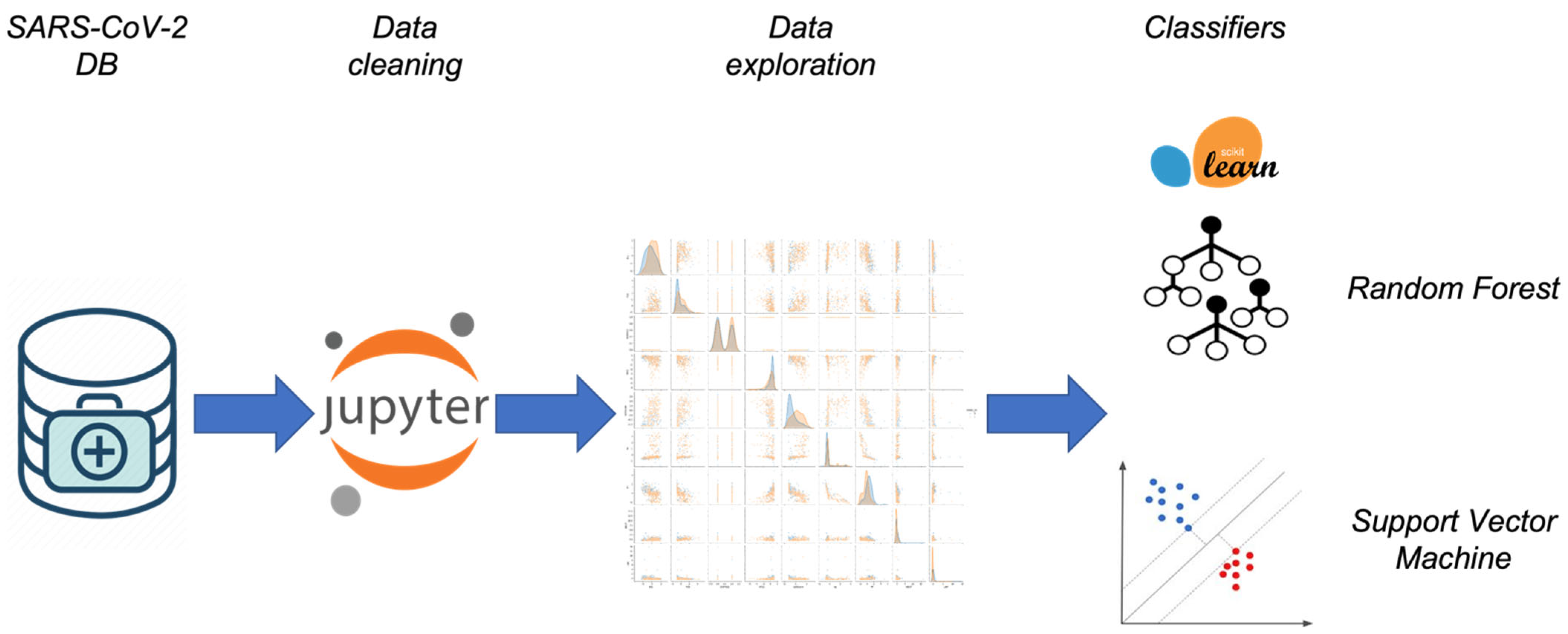
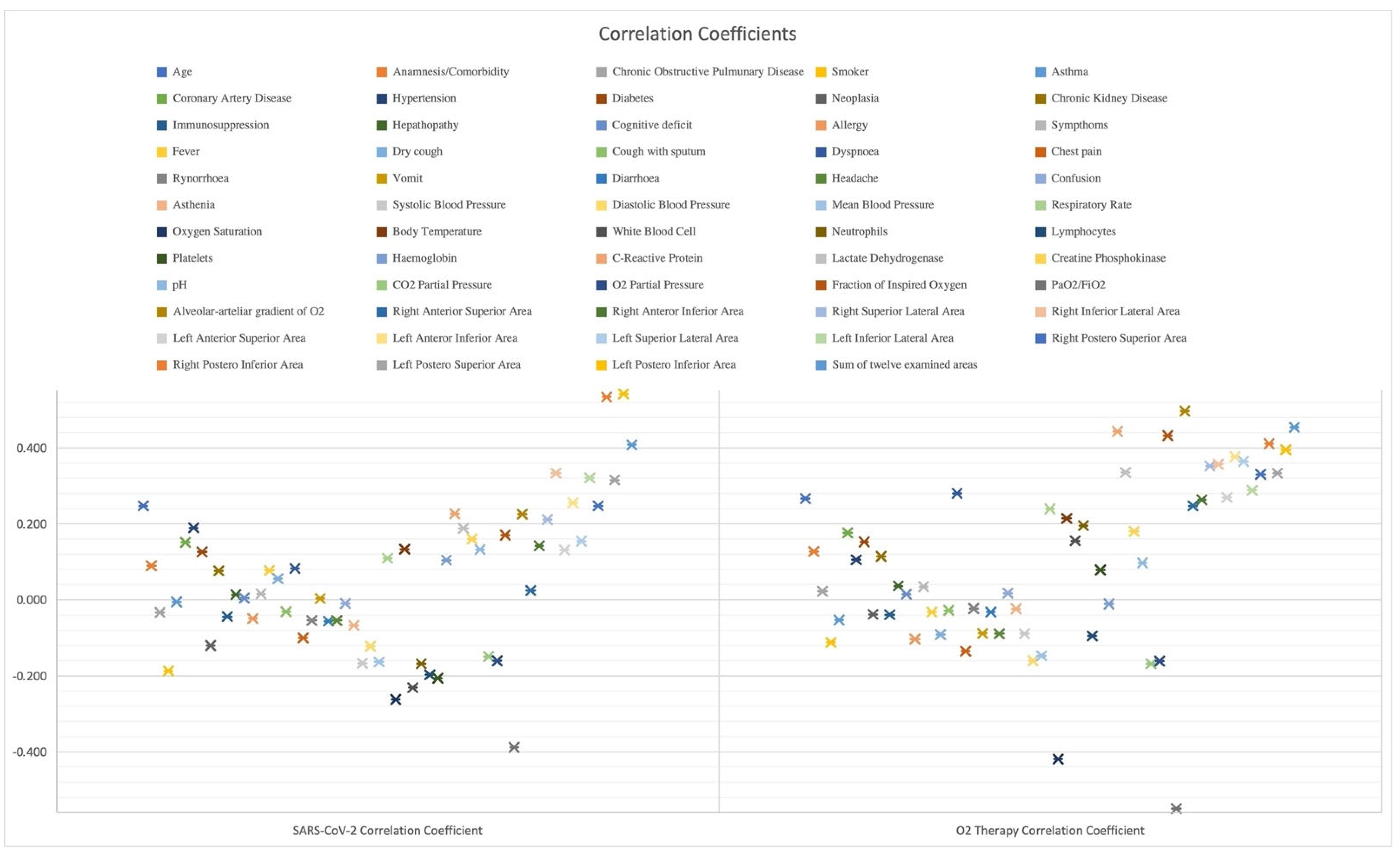
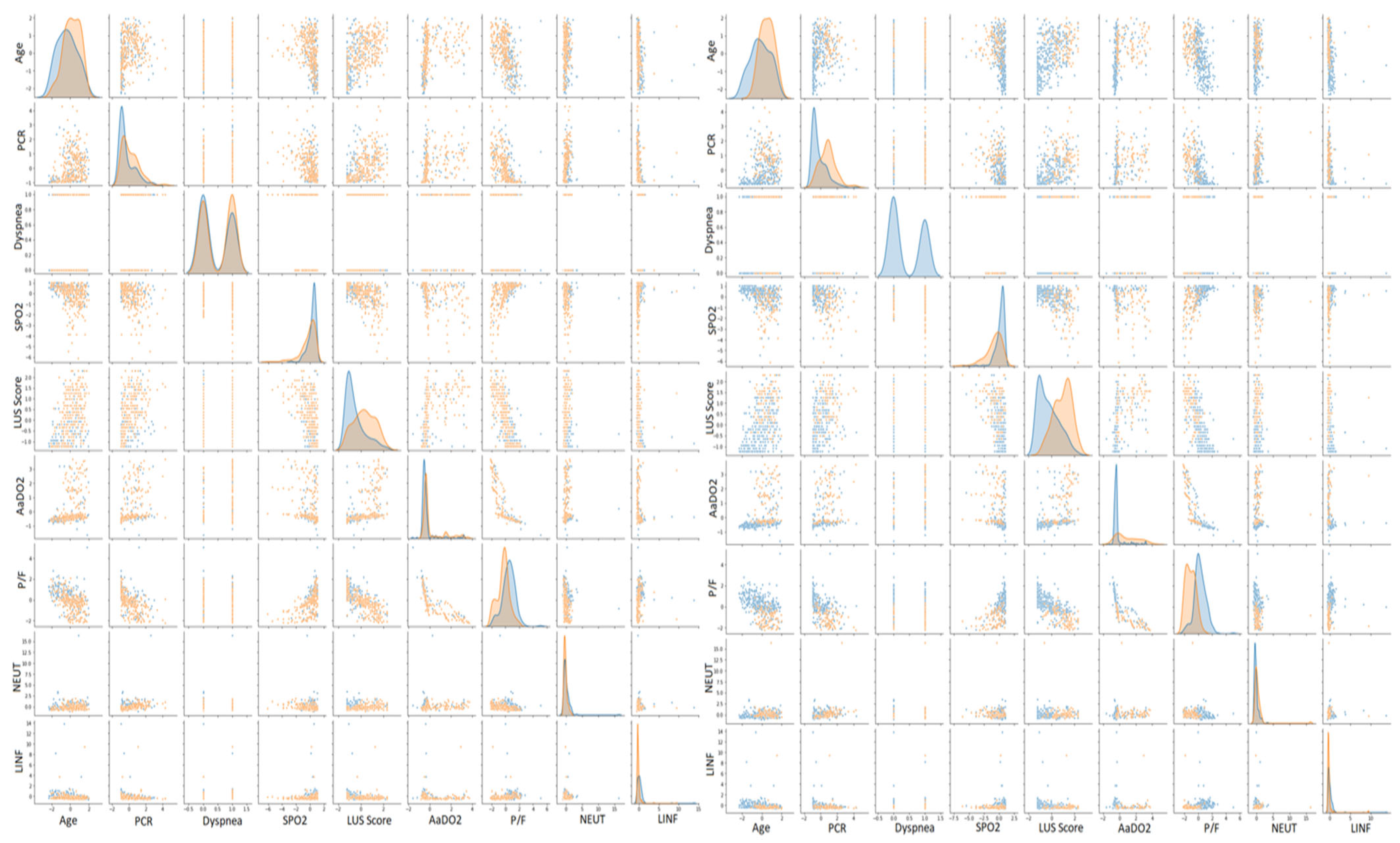

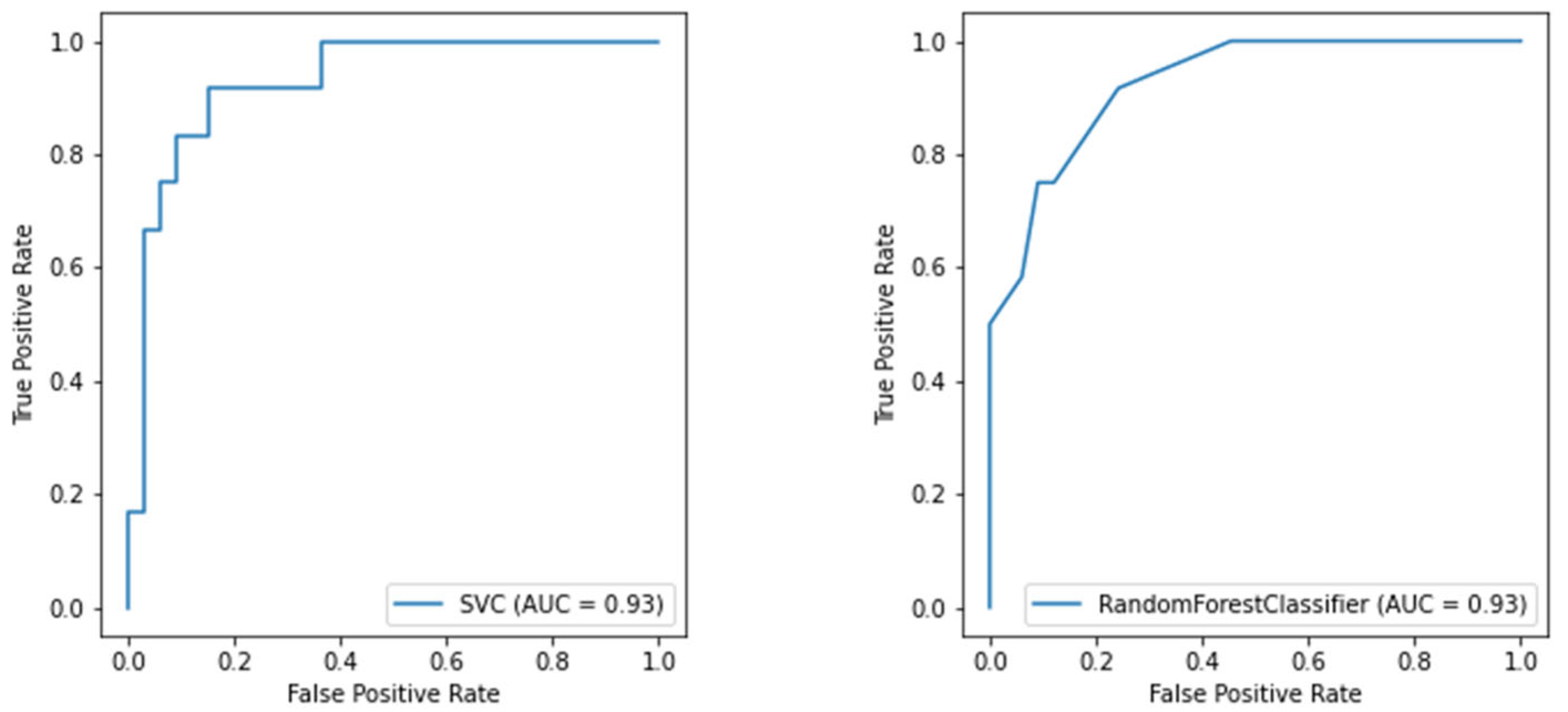
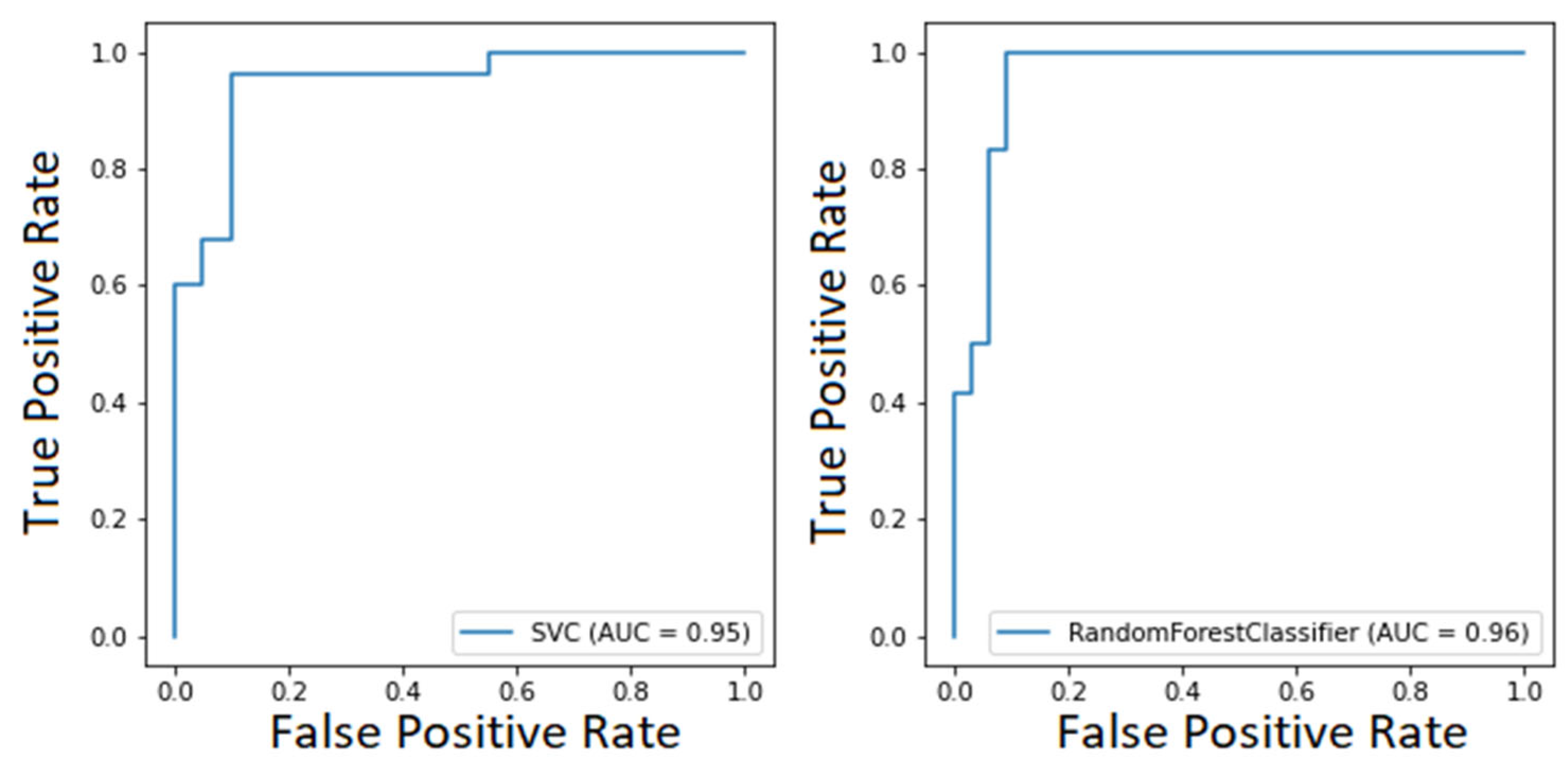

| Negative (172 Patients) | Positive (271 Patients) | Positive and Negative (443 Patients) | [36]. 838 Negative. 786 Positive | |
|---|---|---|---|---|
| 25–75 Percentile (Median) | 25–75 Percentile (Median) | 25–75 Percentile (Median) | 25–75 Percentile (Median) | |
| Age (years) | 37.0–67.5 (54) | 51.0–75.0 (63) | 47.0–73.0 (60) | 48.0–77.0 (62) |
| Systolic bp (mmHg) | 125.0–150.0 (135) | 115.5–144.0 (130) | 120.0–145.0 (130) | |
| Diastolic bp (mmHg) | 70.0–90.0 (80) | 70.0–85.8 (80) | 70.0–90.0 (80) | |
| Mean bp (mmHg) | 91.6–106.7 (100) | 88.3–104.3 (95) | 90.0–105.0 (96.7) | |
| Respiratory rate | 16.0–22.0 (20) | 16.0–26.0 (20) | 16.0–24.0 (20) | |
| Oxygen saturation (%) | 94.0–98.0 (97) | 90.0–97.0 (94) | 91.0–98.0 (95) | |
| Body temperature (°C) | 36.2–37.6 (36.7) | 36.5–38.0 (37.1) | 36.3–37.9 (37) | |
| Hemoglobin (g/dL) | 12.2–14.9 (13.5) | 12.8–14.9 (13.9) | 12.6–14.9 (13.7) | 11.8–14.6 (13.4) |
| White blood cell (109/L) | 6.3–11.5 (8.2) | 4.8–8.1 (6.3) | 5.2–9.2 (6.9) | 5.7–10.7 (7.8) |
| Neutrophils (109/L) | 3.7–9.2 (5.6) | 3.2–6.6 (4.6) | 3.4–7.1 (4.9) | 3.7–8.1 (5.3) |
| Lymphocytes (109/L) | 0.9–2.2 (1.6) | 0.6–1.1 (0.8) | 0.7–1.6 (1) | 0.8–1.7 (1.2) |
| Platelets (109/L) | 179.5–272.5 (224.5) | 146.0–239.0 (184) | 157.0–256.8 (204) | 171.0–282.0 (222.3) |
| C-reactive protein (mg/dL) | 0.1–10.5 (1.3) | 2.6–15.2 (7.9) | 0.9–14.4 (5.3) | 0.6–10.2 (3.9) |
| Lactate dehydrogenase (U/L) | 182.0–290.0 (222) | 243.5–428.0 (326) | 211.3–399.8 (286) | 218.4–388.8 (278) |
| Creatine phosphokinase (U/L) | 51.0–143.0 (86) | 68.0–293.5 (113) | 62.0–217.8 (99) | 53.0–162.5 (86) |
| PH | 7.4–7.5 (7.4) | 7.4–7.5 (7.5) | 7.4–7.5 (7.4) | |
| O2 pp (mmHg) | 69.5–102.0 (84.8) | 58.7–82.2 (68.7) | 62.6–92.8 (74.1) | |
| CO2 pp (mmHg) | 31.4–38.6 (35.7) | 29.6–35.8 (33) | 30.3–37.0 (33.9) | |
| PaO2/FiO2 | 317.6–462.9 (392.2) | 226.4–352.7 (299.5) | 256.1–405.8 (323.8) | |
| A-a-g of O2 (mmHg) | 9.6–42.6 (22.5) | 33.6–93.1 (47.3) | 20.8–60.9 (40.4) | |
| LUS Score | 0.0–7.5 (2) | 6.0–16.0 (11) | 2.0–13.0 (7) |
| Model | Hyperparameter | COVID-19 Prediction | Dyspnea Prediction |
|---|---|---|---|
| RF | n_estimators | 550 | 500 |
| max_depth | 2 | 2 | |
| min_samples_split | 1 | 1 | |
| max_features | 50 | None | |
| min_samples_leaf | Auto | Auto | |
| bootstrap | True | True | |
| SVM | C | 1 | 1 |
| γ | 0.01 | 0.01 | |
| kernel | RBF | Sigmoid |
| Classification Task | Model | AUC | Accuracy | Precision | Recall | F1 Score |
|---|---|---|---|---|---|---|
| COVID-19 | RF | 93.0% | 91.0% | 89.0% | 96.0% | 92.0% |
| SVM | 95.0% | 91.0% | 89.0% | 96.0% | 92.0% | |
| Oxygen Therapy | RF | 96.0% | 91.0% | 83.0% | 83.0% | 83.0% |
| SVM | 93.0% | 87.0% | 80.0% | 67.0% | 73.0% |
| Models | Features | Patients | AUC. | Accuracy | Specificity | Recall | F1 Score | |
|---|---|---|---|---|---|---|---|---|
| Cabitza et al. | Knn, Naïve Bayes, RF, SVM, Logistic Regression | 72 | 1624 | 76.0% | 78.0% | 82.0% | 74.0% | - |
| Goodman-Meza et al. | Multilayer Perceptron, Naïve Bayes, RF, SVM, Logistic Regression, XGBoost, ADABoost | 12 | 1455 | 91.0% | - | 64.0% | 93.0% | - |
| Plante et al. | XGBoost | 15 | 192,779 | 91.0% | - | 42.0% | 96.0% | - |
Publisher’s Note: MDPI stays neutral with regard to jurisdictional claims in published maps and institutional affiliations. |
© 2022 by the authors. Licensee MDPI, Basel, Switzerland. This article is an open access article distributed under the terms and conditions of the Creative Commons Attribution (CC BY) license (https://creativecommons.org/licenses/by/4.0/).
Share and Cite
La Salvia, M.; Torti, E.; Secco, G.; Bellazzi, C.; Salinaro, F.; Lago, P.; Danese, G.; Perlini, S.; Leporati, F. Machine-Learning-Based COVID-19 and Dyspnoea Prediction Systems for the Emergency Department. Appl. Sci. 2022, 12, 10869. https://doi.org/10.3390/app122110869
La Salvia M, Torti E, Secco G, Bellazzi C, Salinaro F, Lago P, Danese G, Perlini S, Leporati F. Machine-Learning-Based COVID-19 and Dyspnoea Prediction Systems for the Emergency Department. Applied Sciences. 2022; 12(21):10869. https://doi.org/10.3390/app122110869
Chicago/Turabian StyleLa Salvia, Marco, Emanuele Torti, Gianmarco Secco, Carlo Bellazzi, Francesco Salinaro, Paolo Lago, Giovanni Danese, Stefano Perlini, and Francesco Leporati. 2022. "Machine-Learning-Based COVID-19 and Dyspnoea Prediction Systems for the Emergency Department" Applied Sciences 12, no. 21: 10869. https://doi.org/10.3390/app122110869
APA StyleLa Salvia, M., Torti, E., Secco, G., Bellazzi, C., Salinaro, F., Lago, P., Danese, G., Perlini, S., & Leporati, F. (2022). Machine-Learning-Based COVID-19 and Dyspnoea Prediction Systems for the Emergency Department. Applied Sciences, 12(21), 10869. https://doi.org/10.3390/app122110869










